 |
Pocahontas and her Forest Friends |
||||
|
|
|||||
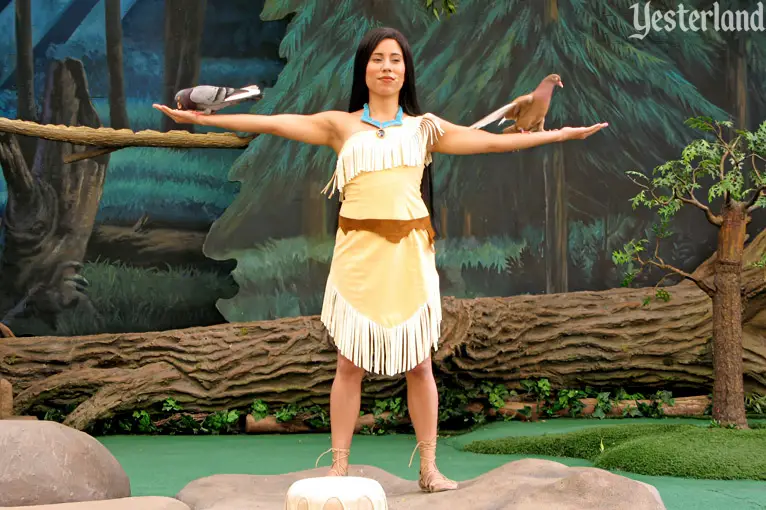
Photo by Werner Weiss, 2008 |
|||||
|
|
|||||
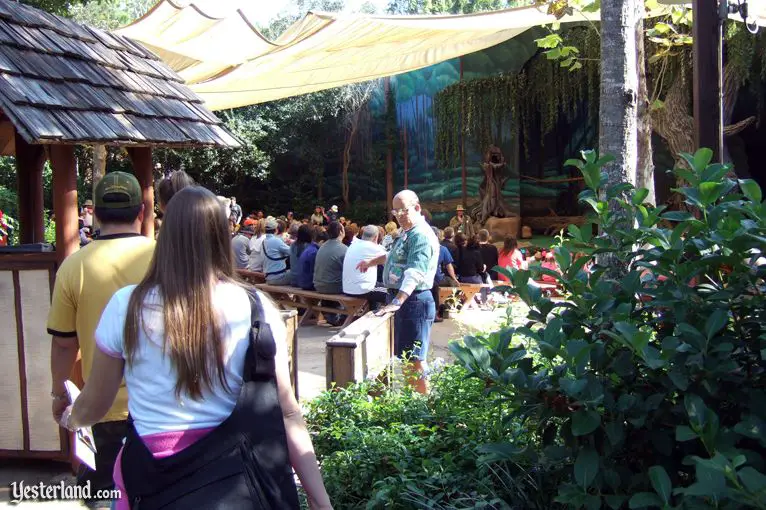
Photo by Allen Huffman, 2006 Entering Grandmother Willow’s Grove |
|||||
|
It’s almost show time at Grandmother Willow’s Grove. Find a spot on a bench in this 350-seat outdoor theater for Pocahontas and Forest Friends. The first four rows are reserved for children. Oh, you can’t bring food into the theater; there are animals and they might want your food. The 12-minute show features the title character from the 1995 Disney animated feature Pocahontas, a small menagerie of trained critters, and two talking trees—one very young, one very old. |
|||||
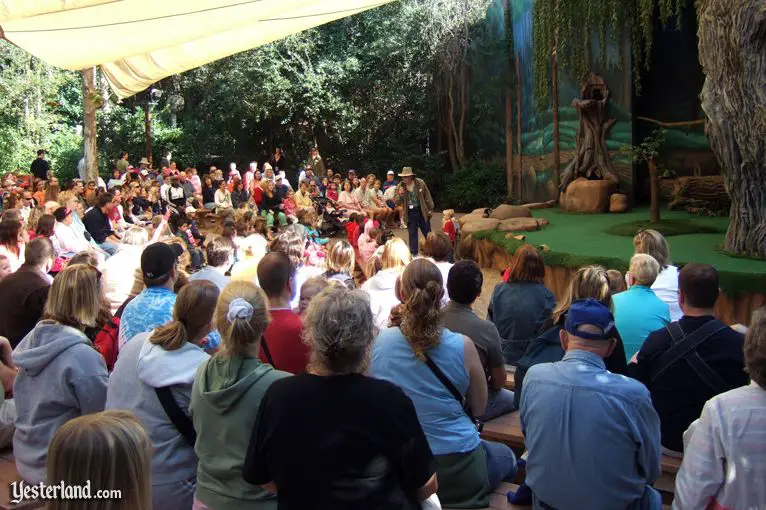
Photo by Allen Huffman, 2006 A “camp counselor” getting kids involved before the show |
|||||
|
You won’t see Captain John Smith, Chief Powhatan, Governor Ratcliffe, or manservant Wiggins on stage. This isn’t one of those theme park shows that retells a movie in an abbreviated form. But Meeko is usually in the show—played not by an actor in a Meeko costume, but by an actual raccoon. The show is starting... |
|||||
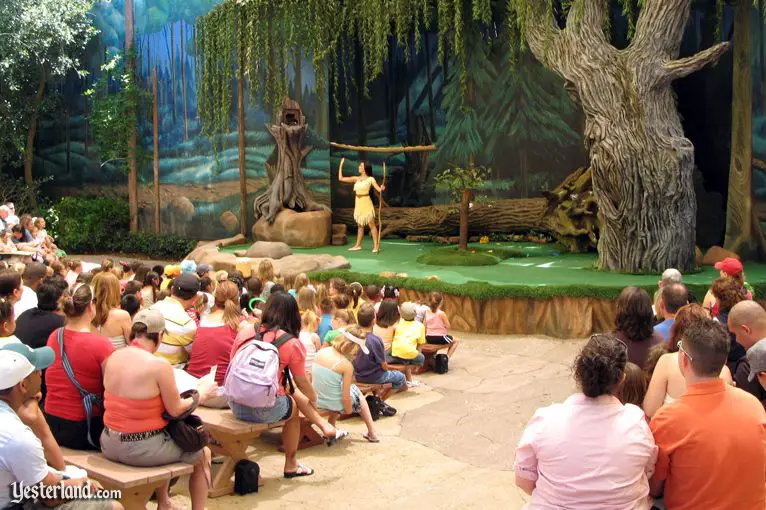
Photo by Werner Weiss, 2007 Pocahontas singing “Colors of the Wind’ |
|||||
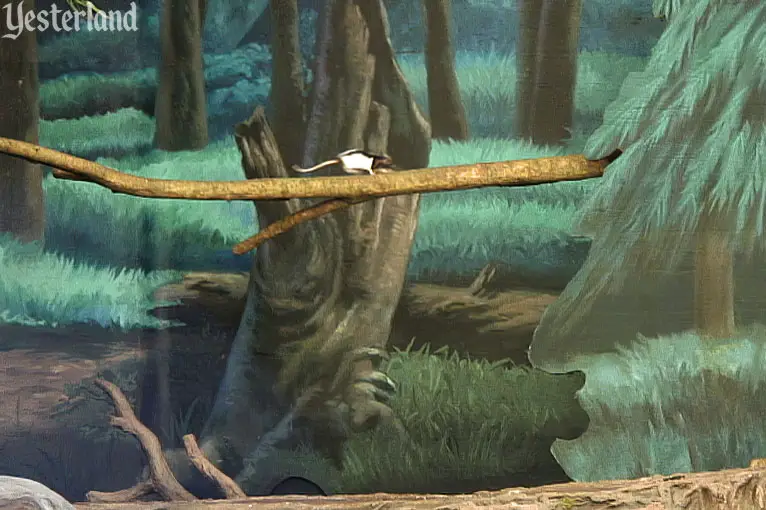
Photo by Werner Weiss, 2007 Rat |
|||||
|
The music starts. A turkey runs on the stage. Rats scamper along a branch. “Wingapo,” says Pocanontas after singing “Colors of the Wind.” “That is how I say hello. Can you say wingapo? Try it with me!” The audience responds, “win-ga-po.” “I am so happy to see so many friends of the forest. Do you know what my favorite part of the forest is?” asks Pocanontas. “It is my animal friends that live here! Do you know who they are?” You’re about to find out. |
|||||
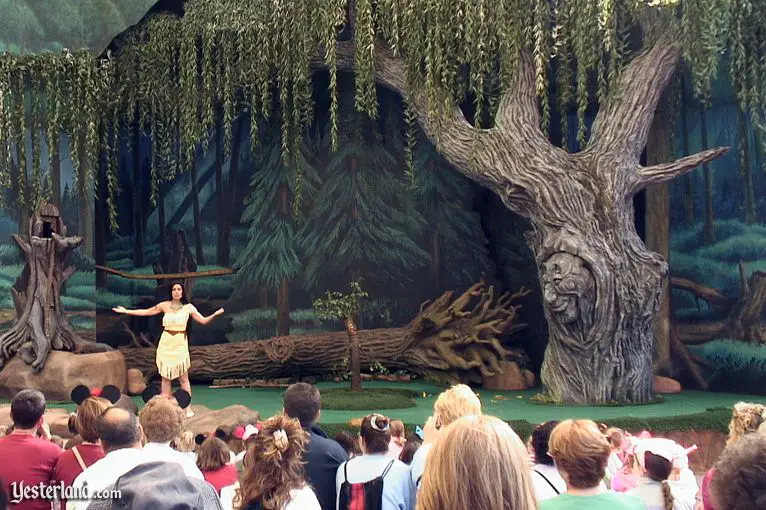
Photo by Allen Huffman, 2006 Pocahontas, little Sprig, and wise old Grandmother Willow |
|||||
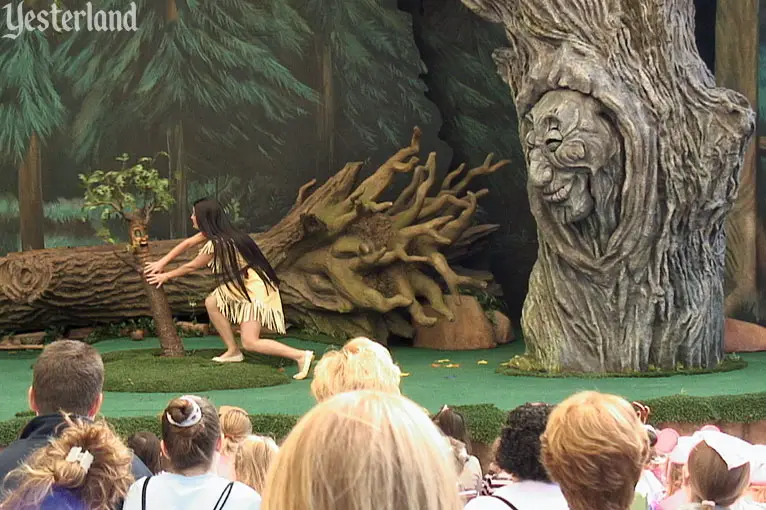
Photo by Allen Huffman, 2006 Spring and Pocahontas, worried about the forest |
|||||
|
There’s a crisis in the forest. As Pocahontas tells Grandmother Willow, “We have to do something. The forest is in trouble. It is being cut down tree by tree, limb by limb. They’re not even leaving a twig in their path!” |
|||||
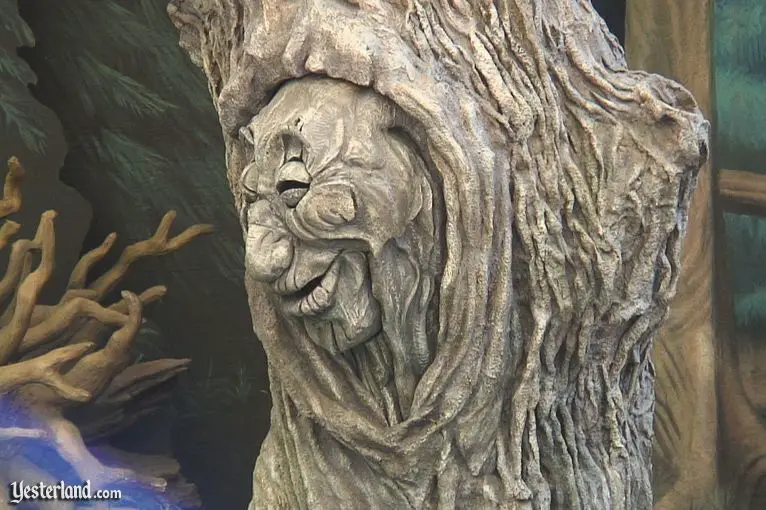
Photo by Allen Huffman, 2006 Grandmother Willow |
|||||
|
With the wisdom of age, Grandmother Willow calmy asks, “Pocahontas, have you forgotten the prophecy of the forest?” One creature has a special gift to protect the forest. But what creature is that? Now it’s up to a series of animals to provide a series of clues to Pocahontas—and to teach Sprig an important lesson. |
|||||
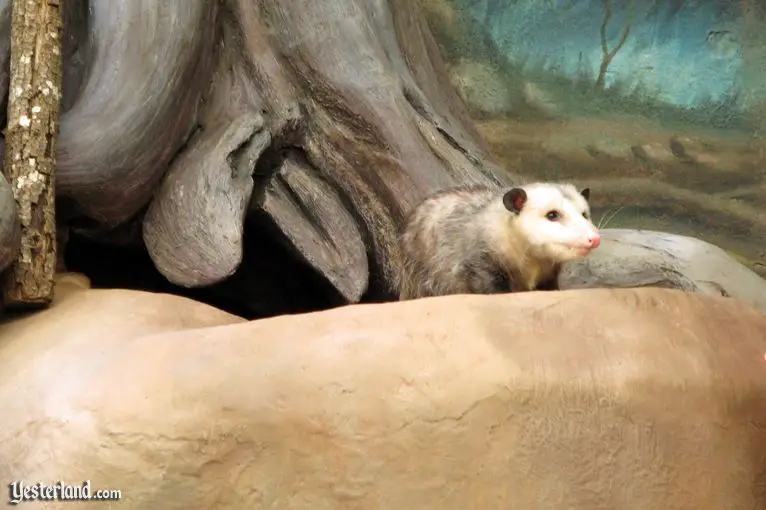
Photo by Werner Weiss, 2007 Possum |
|||||
|
A possum appears. Sprig is not impressed. Grandmother Willow enlightens the little sapling, “Well Sprig, just like you have tender roots, the possum has quite a tender heart. Instead of fighting, he protects himself by playing dead.” “So the possum teaches us to use strategy to help us solve our problems,” concludes Pocahontas. |
|||||
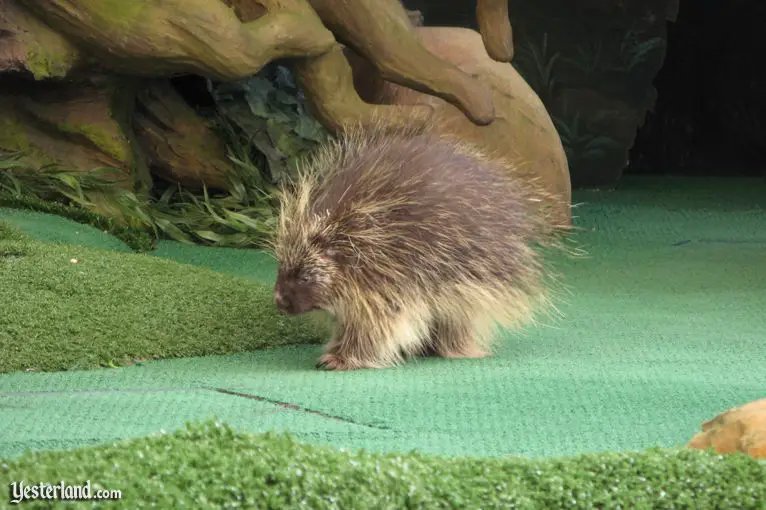
Photo by Werner Weiss, 2008 Porcupine |
|||||
|
The next creature is a porcupine “The porcupine is like my father Chief Powhatan,” observes Pocahontas. “If you treat him well, he is very friendly. But when threatened, his quills stand straight up!” Grandmother Willow explains the clue: “The porcupine represents faith and trust. He reminds us that we can accomplish great things as long as we truly believe we can.” |
|||||
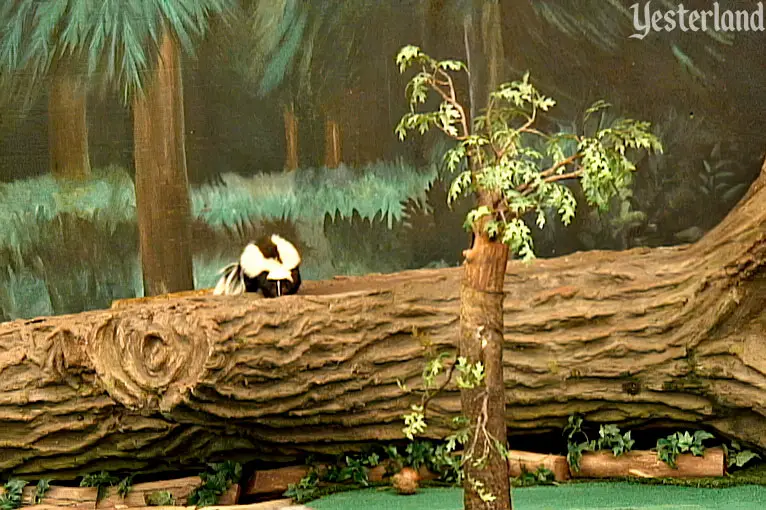
Photo by Allen Huffman, 2006 Skunk |
|||||
|
All that Sprig knows about the next creature, a skunk, is its smell. Grandmother Willow explains, “The skunk only releases that foul odor if he believes he’s in danger.” It’s another clue for Pocahontas. She remarks, “The smell and his spray teach us about respect.” |
|||||
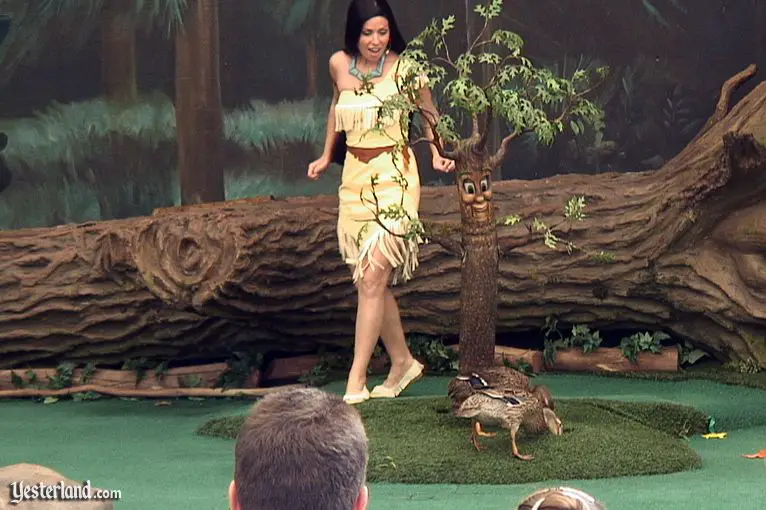
Photo by Allen Huffman, 2006 Ducks |
|||||
|
What can we learn from ducks? Pocahontas knows. “Though ducks are small, they have their own message. They show us we should take control of the things that scare us. Otherwise our fears could become real.” |
|||||

Photo by Allen Huffman, 2006 Snake |
|||||
|
Sprig is terrified when Pocahontas appears with a snake, but she calms him with this observation: “Without my friend the snake, some animal populations would grow so large that they would threaten the life of the forest—if he did not do what he must to survive.” |
|||||
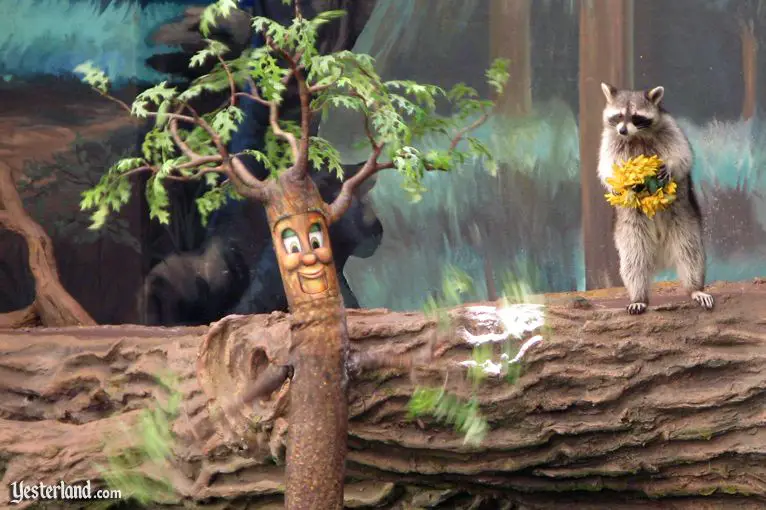
Photo by Werner Weiss, 2007 Sprig the sapling and Meeko the raccoon |
|||||
|
When a raccoon appears with flowers, it’s the final clue for Pocahontas. “Meeko came to me for protection,” she notes. “So even though each animal protects itself, it takes all of us to protect the forest.” |
|||||
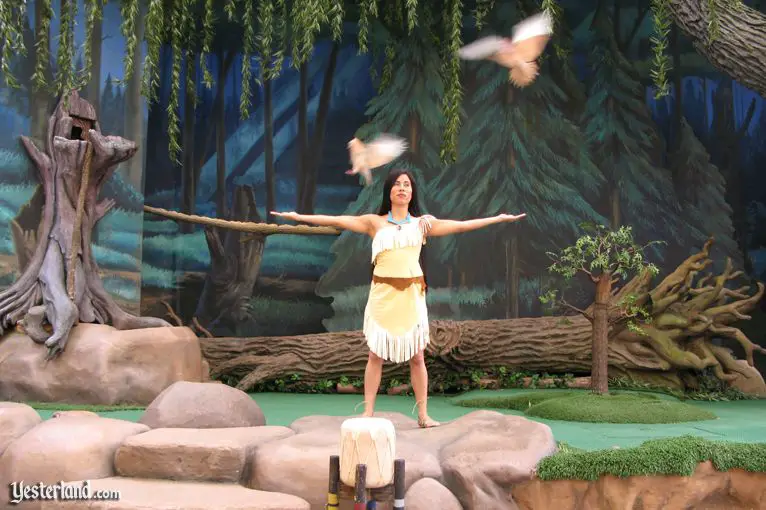
Photo by Werner Weiss, 2008 Take flight! |
|||||
|
The secret is no longer a secret. Pocahontas knows the answer. “The prophecy said that one of the creatures of the forest has a special gift to protect it. That creature must be us. Humans can destroy the forest, but we can also save it. The Earth is our home too. If we take care of it, it will take care of us!” |
|||||
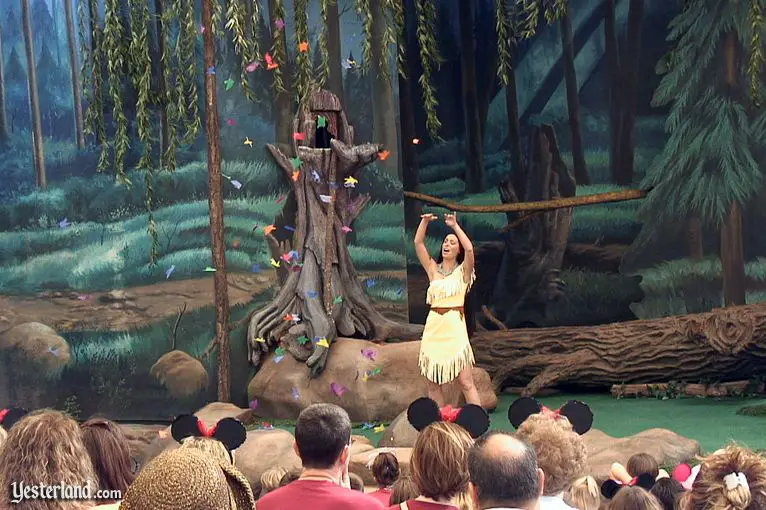
Photo by Allen Huffman, 2006 Reprise of “Colors of the Wind’ |
|||||
|
There were plenty of animals in the show—but not a bobcat. If you were hoping Pocahontas would ask the grinning bobcat why he grins, you’ll never know. |
|||||
|
|
|||||
|
Pocahontas and her Forest Friends opened in April 1998 at Camp Minnie-Mickey, the “temporary land” at Disney’s Animal Kingdom. The fourth theme park at Walt Disney World was brand new. Animal demonstrations are a staple of zoos all over the United States. Typically, guests sit in an outdoor theater as two or three trainers bring out one animal at a time and talk about that animal’s characteristics. |
|||||

Photo by Werner Weiss, 2009 Animal demonstration at Miami MetroZoo (now called Zoo Miami) |
|||||
|
Disney wanted to offer more to its guests—a performance with Disney showmanship, a story, Disney music, and a well-known “star” from an animated Disney feature. It was a modest show. In fact, the official Walt Disney World website in 2001 listed Pocahontas and Her Forest Friends under “Meet the Characters,” not under “Shows.” It was an enjoyable show, especially for children, people who love animals, and fans of Pocahontas. When everything went perfectly, it was slick and polished. And when one or more of the animals didn’t do what it was supposed to, it was even more fun. The economic crash of 2008 caused Disney to take a hard look at its Parks and Resorts budgets for the fiscal year 2009, which would begin October 1, 2008. The big news was the decision that the clubs of Pleasure Island would close on September 28, 2008, after almost two decades of operation. Around the same time, entertainment cutbacks at Epcot’s World Showcase sent Orisi Risi and Spelmanns Gledje packing. At Magic Kingdom, Woody’s Cowboy Camp pulled its stakes and the Main Street Family Fun Day Parade marched away. At Disney’s Hollywood Studios, Fantasmic! stayed dark five nights each week and the a cappella singing group 4 for a Dollar was silenced. Disney’s Animal Kingdom was not immune. The final performance of Pocahontas and Her Forest Friends was on September 27, 2008. Grandmother Willow’s Grove became a smoking area and a stroller parking lot. |
|||||

Photo by Werner Weiss, 2011 One of two new uses for Grandmother Willow’s Grove |
|||||
|
I mentioned to Disney historian Jim Korkis that I was working on a Yesterland article about Pocahontas and Her Forest Friends. I discovered that Jim was there when the show was being developed. Werner Weiss: So this was back in 1998… Jim Korkis: At the time, I was working as an animation instructor at the Disney Institute. My brother, Michael, who had been a performer at Walt Disney World, was moved into a position as a Show Writer and Director. One of his first assignments in that role was to write and direct that show. He and I talked quite extensively about the character of Pocahontas and her world because of my knowledge of Disney animation. I knew a lot about the story behind the film and some of the decisions that were made about the story and the characters. Werner: Was the show your brother’s idea? Jim: The genesis of the show came from the animal education cast at Disney’s Animal Kingdom. It would have been just like those animal meet-and-greet shows at zoos and other animal parks like Gatorland. However, Disney Entertainment saw it as an opportunity to expand into a show that would make it seem like there was a little more going on at Camp Minnie-Mickey. That’s when my brother became involved. Werner: How far along was the concept? Jim: The elements of a show—Pocahontas (singing “Colors of the Wind” at some point), Grandmother Willow, Sprig, and some live animal interaction—were already in place when the project was given to Michael. His job was to utilize those elements to create a coherent 10- to 15-minute experience for a young audience. It was assumed that a young child’s attention span would not last longer than that amount of time. Werner: I don’t recall Sprig being in the movie Pocahontas. Jim: Sprig was to be the “identification figure.” That term came from children’s television animation in the 1980s and 1990s, when it was believed that a young child could only relate to an animated series if there was a character similar in age involved in the stories. This belief resulted in a lot of children—usually smarter than the adults—or small characters who acted like children in the block of Disney Afternoon animated cartoons—Duck Tales, Tale Spin, Goof Troop, and others. While never stated in the production, it was assumed that Sprig had somehow been born from some part of Grandmother Willow like an acorn—although, as a willow, she had no acorns—and Grandmother Willow was babysitting her eager grandchild. She doesn’t mention any other children or grandchildren trees. Werner: Before the official grand opening of Disney’s Animal Kingdom, I visited the park during a preview for on-site Walt Disney World guests. Most things were up and running, but they were still working on the animal show starring Pocahontas. Jim: It was a last-minute addition to Camp Minnie-Mickey, an area of the park that itself was a last-minute addition to replace the proposed Beastlie Kingdomme. The show was originally called Colors Of The Wind, Friends from the Animal Forest. That title was awkward. It didn’t even mention Pocahontas, who was the star. In the rush to get the show up and running, no one paid much attention. Guests quickly started referring to the production as just the Pocahontas show and Disney wisely came up with a simpler title. Werner: For a last-minute effort, that show certainly had a long run. Jim: The show was supposed to be just a temporary placeholder to last perhaps two years, just to add something to that area when the park first opened until something else would take its place. At the time, no one expected that it would last almost a decade. In addition, because it was in the Camp Minnie-Mickey area, it was to appeal to a young demographic—to communicate with a “spoonful of sugar” to children the fact that it is our responsibility to protect our forest friends and the environment. While some Disney fans felt that message was too preachy, it needed to be clear and simple for young children who took it to heart. |
|||||

Photo by Werner Weiss, 2011 The other new use for Grandmother Willow’s Grove |
|||||
|
Werner: It seems that a lot of thought was put into the “temporary” animal show. Jim: Two top show writers at Walt Disney World, Bob Glickman (who wrote material and directed me when I performed as Prospector Pat in Magic Kingdom’s Frontierland) and David Duffy (who is now a Show Director at Disney Cruise Line) contributed to the final script as well. There are always many different hands involved in any Disney show. Werner: I guess it was a challenge to write the script, considering that animals are unpredictable. Jim: I know they struggled with the script right up to opening because which animals would be available was constantly changing for a variety of reasons. As a result, segments had to be rewritten and yet be seamlessly incorporated into the broader story. The animals were not trained to perform specifically for the show. The show was written to adapt to their natural behaviors. The animals can sometimes decide they don’t want to appear which is why so many different types of animals rotated throughout the years. Also, some of those animals are nocturnal so that they are awake enough to make an appearance at all can be amazing. Werner: I didn’t know that carrying a bouquet of flowers while walking on its hind legs is a natural behavior for a raccoon. Jim: Raccoons can walk upright for a short distance and can carry things in their paws. It was a Disney “show touch” to substitute a bouquet of flowers for a dead fish that a raccoon might carry in nature. It always elicited a favorable reaction from the audience. Werner: I saw the show several times and always enjoyed it, even though it was primarily aimed at children. Jim: I know that some people were disappointed with the show because it didn’t have all the bells and whistles of some Disney stage shows, especially when compared to The Festival of Lion King nearby. I loved the simplicity and softness of the show. There was just a character performer, two puppeteers, and a handful of animals in an intimate setting. The wire cages for the animals during the course of the show were in a covered area directly behind the stage. The puppeteer for Sprig and Grandmother Willow were underneath the stage. Some guests thought those props were Audio-Animatronics, but they were sophisticated puppets. Some items were recycled from other Disney stage productions. Werner: I recognized Grandmother Willow from The Spirit of Pocahontas at Disneyland. Jim: The Festival of Lion King also reused props from Disneyland as a cost saving measure. The four huge floats came from the Lion King Celebration parade. One of the reasons for the cancellation of Beastlie Kingdomme was that Disney’s Animal Kingdom was going tremendously over budget, so any replacement had to be “cost efficient,” as they say at Disney. Werner: I liked how the Grandmother Willow tree had a plain trunk when the show began, but later had her face, even though I never noticed the face being moved into place. Jim: Misdirection is a term used in magic where a magician tricks you to look one place while he is doing something somewhere else. In the show, Pocahontas races urgently across the stage. When she runs quickly, looking eagerly to stage right as if something is coming from that direction, that is when Grandmother Willow’s face appears stage left. The audience is watching Pocahontas because we have a tendency to give our attention to movement, even to a stranger briefly walking by an open door. |
|||||

Photo by Werner Weiss, 2011 Pocahontas meet-and-greet near the show location, three years after its closing |
|||||
|
Werner: The character Pocahontas was a good fit for the conservation message of Disney’s Animal Kingdom. The show opened almost three years after the movie. Jim: Yes. The animated feature Pocahontas had opened with a lot of fanfare in June 1995. The Walt Disney Company, especially Jeffrey Katzenberg, had been quite adamant in telling Disney animators that Pocahontas, not the 1994 feature The Lion King, was going to be the next big, prestigious blockbuster Disney animated feature. As we know, The Lion King truly became the king and outperformed Pocahontas at the box office. However, Disney had already made plans to support Pocahontas in a variety of ways. Around the time of the film’s release, a stage show called The Spirit of Pocahontas opened at both Disneyland and the Disney-MGM Studios Backlot Theater, although each production was different. Werner: I saw them both. I preferred the Disneyland version, which also had a much longer run. Jim: When the Disneyland version of The Spirit of Pocahontas closed in September 1997, it provided an opportunity to reuse the props at Disney’s Animal Kingdom. As I mentioned, they were scrambling to fill Camp Minnie-Mickey without spending much money. It was felt that the environmental message of the Pocahontas story would be a good fit for the park. Werner: While doing research for this article, I found several videos of the show on YouTube, with numerous differences. For example, in an older video, Pocahontas didn’t begin by asking the audience to say “Wingapo.” Jim: Over the years, the show changed, like replacing the types of animals, while still retaining its original core. My brother moved on to other projects, and other directors brought their own vision to the show. Pocahontas and Her Forest Friends did have its fans, one of the reasons it lasted as long as it did, who are sad that it closed and nothing took its place except an occasional meet-and-greet opportunity. Werner: Thank you Jim! All of Camp Minnie-Mickey closed permanently on January 6, 2014. The Festival of the Lion King moved to a new theater in the park’s Africa section, with shows resuming June 1, 2014. Disney had plans for a bigger and better land. Pandora—The World of Avatar opened May 27, 2017, replacing Camp Minnie-Mickey and the vacant parcel adjacent to it. Disney often looks for opportunities to salvage and reuse infrastructure and existing show elements. But not this time. So we never got Neytiri and her Pandoran Forest Friends. |
|||||
|
Disney historian Jim Korkis is the author of many books about Disney parks, Disney movies, and Walt Disney. Here are two books you might enjoy. Click on the Amazon links below to learn more about these and other books by Korkis. |
|||||
|
|||||
|
Yesterland is a participant in the Amazon Services LLC Associates Program, an affiliate advertising program designed to provide a means for sites to earn advertising fees by advertising and linking to Amazon.” That means Yesterland benefits financially if you buy this book (and any other items at Amazon) using a link in this article. |
|||||
|
|
Click here to post comments at MiceChat about this article.
© 2012-2020 Werner Weiss — Disclaimers, Copyright, and Trademarks Updated June 5, 2020 |
||||